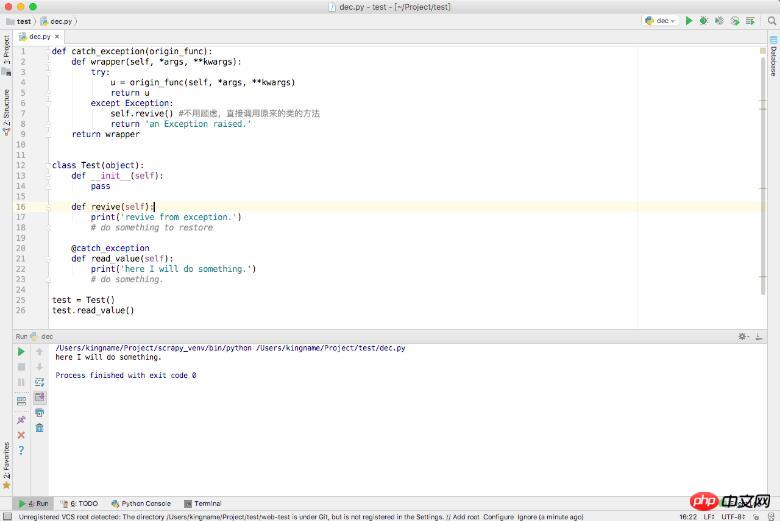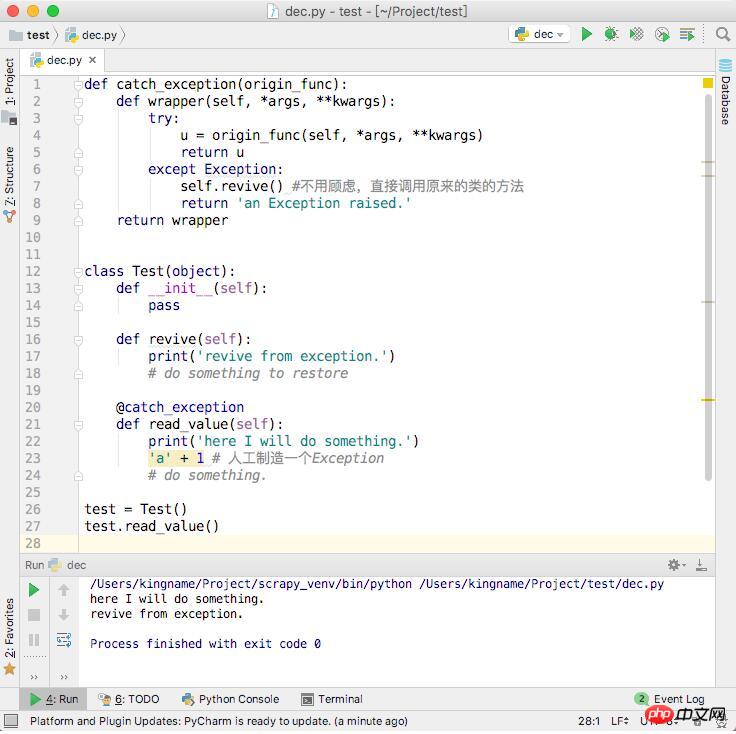Decorate methods in classes based on Python decorators
Let me share with you an example of a method based on the Python decorator decoration class. It has a good reference value and I hope it will be helpful to everyone. Let’s take a look together
title: Methods in Python decorator decoration classes
comments: true
date: 2017-04-17 20:44: 31
tags: ['Python', 'Decorate']
category: ['Python']
---
At present, most of the information about Decorator tutorials all talk about how to decorate an ordinary function. This article introduces how to use Python's decorator to decorate a class method and call other methods in the class in the decorator function. This article takes catching an exception from a method as an example to illustrate.
There is a class Test, its structure is as follows:
class Test(object): def __init__(self): pass def revive(self): print('revive from exception.') # do something to restore def read_value(self): print('here I will do something.') # do something.
In the class There is a method read_value(), which is called in multiple places. For some reasons, the method read_value may randomly throw Exception and cause the program to crash. So you need to do try...except processing on the entire method. The ugliest approach is shown in the following code:
class Test(object):
def __init__(self):
pass
def revive(self):
print('revive from exception.')
# do something to restore
def read_value(self):
try:
print('here I will do something.')
# do something.
except Exception as e:
print(f'exception {e} raised, parse exception.')
# do other thing.
self.revive()Writing like this can solve the problem, but the code is not Pythonic.
Use decorators to solve this problem. Should the decorator function be written inside the class or outside the class? The answer is, write it outside the class. So since it is written outside the class, how to call other methods of this class?
First write one of the most common decorators for handling exceptions:
def catch_exception(origin_func): def wrapper(*args, **kwargs): try: u = origin_func(*args, **kwargs) return u except Exception: return 'an Exception raised.' return wrapper class Test(object): def __init__(self): pass def revive(self): print('revive from exception.') # do something to restore @catch_exception def read_value(self): print('here I will do something.') # do something.
This way of writing can indeed capture the exception of origin_func(), but what should we do if we need to call another method in the class to handle the exception when an exception occurs? The answer is to add a parameter to the wrapper: self.
The code becomes the following form:
def catch_exception(origin_func): def wrapper(self, *args, **kwargs): try: u = origin_func(self, *args, **kwargs) return u except Exception: self.revive() #不用顾虑,直接调用原来的类的方法 return 'an Exception raised.' return wrapper class Test(object): def __init__(self): pass def revive(self): print('revive from exception.') # do something to restore @catch_exception def read_value(self): print('here I will do something.') # do something.
Only the part defined by the decorator needs to be modified, and no modification is required where the decorator is used.
The following picture shows the running results during normal operation:

The following picture shows the capture after an exception occurs And handle exceptions:

# By adding a self parameter, the decorator outside the class can directly use various methods in the class, or directly use the attributes of the class.
Related recommendations:
python decorator - method to limit the number of function calls (call once every 10 seconds)
The above is the detailed content of Decorate methods in classes based on Python decorators. For more information, please follow other related articles on the PHP Chinese website!

Hot AI Tools

Undresser.AI Undress
AI-powered app for creating realistic nude photos

AI Clothes Remover
Online AI tool for removing clothes from photos.

Undress AI Tool
Undress images for free

Clothoff.io
AI clothes remover

Video Face Swap
Swap faces in any video effortlessly with our completely free AI face swap tool!

Hot Article

Hot Tools

Notepad++7.3.1
Easy-to-use and free code editor

SublimeText3 Chinese version
Chinese version, very easy to use

Zend Studio 13.0.1
Powerful PHP integrated development environment

Dreamweaver CS6
Visual web development tools

SublimeText3 Mac version
God-level code editing software (SublimeText3)

Hot Topics
 1387
1387
 52
52
 Is the vscode extension malicious?
Apr 15, 2025 pm 07:57 PM
Is the vscode extension malicious?
Apr 15, 2025 pm 07:57 PM
VS Code extensions pose malicious risks, such as hiding malicious code, exploiting vulnerabilities, and masturbating as legitimate extensions. Methods to identify malicious extensions include: checking publishers, reading comments, checking code, and installing with caution. Security measures also include: security awareness, good habits, regular updates and antivirus software.
 How to run programs in terminal vscode
Apr 15, 2025 pm 06:42 PM
How to run programs in terminal vscode
Apr 15, 2025 pm 06:42 PM
In VS Code, you can run the program in the terminal through the following steps: Prepare the code and open the integrated terminal to ensure that the code directory is consistent with the terminal working directory. Select the run command according to the programming language (such as Python's python your_file_name.py) to check whether it runs successfully and resolve errors. Use the debugger to improve debugging efficiency.
 Can vs code run in Windows 8
Apr 15, 2025 pm 07:24 PM
Can vs code run in Windows 8
Apr 15, 2025 pm 07:24 PM
VS Code can run on Windows 8, but the experience may not be great. First make sure the system has been updated to the latest patch, then download the VS Code installation package that matches the system architecture and install it as prompted. After installation, be aware that some extensions may be incompatible with Windows 8 and need to look for alternative extensions or use newer Windows systems in a virtual machine. Install the necessary extensions to check whether they work properly. Although VS Code is feasible on Windows 8, it is recommended to upgrade to a newer Windows system for a better development experience and security.
 Can visual studio code be used in python
Apr 15, 2025 pm 08:18 PM
Can visual studio code be used in python
Apr 15, 2025 pm 08:18 PM
VS Code can be used to write Python and provides many features that make it an ideal tool for developing Python applications. It allows users to: install Python extensions to get functions such as code completion, syntax highlighting, and debugging. Use the debugger to track code step by step, find and fix errors. Integrate Git for version control. Use code formatting tools to maintain code consistency. Use the Linting tool to spot potential problems ahead of time.
 Choosing Between PHP and Python: A Guide
Apr 18, 2025 am 12:24 AM
Choosing Between PHP and Python: A Guide
Apr 18, 2025 am 12:24 AM
PHP is suitable for web development and rapid prototyping, and Python is suitable for data science and machine learning. 1.PHP is used for dynamic web development, with simple syntax and suitable for rapid development. 2. Python has concise syntax, is suitable for multiple fields, and has a strong library ecosystem.
 Can vscode be used for mac
Apr 15, 2025 pm 07:36 PM
Can vscode be used for mac
Apr 15, 2025 pm 07:36 PM
VS Code is available on Mac. It has powerful extensions, Git integration, terminal and debugger, and also offers a wealth of setup options. However, for particularly large projects or highly professional development, VS Code may have performance or functional limitations.
 PHP and Python: Different Paradigms Explained
Apr 18, 2025 am 12:26 AM
PHP and Python: Different Paradigms Explained
Apr 18, 2025 am 12:26 AM
PHP is mainly procedural programming, but also supports object-oriented programming (OOP); Python supports a variety of paradigms, including OOP, functional and procedural programming. PHP is suitable for web development, and Python is suitable for a variety of applications such as data analysis and machine learning.
 Can vscode run ipynb
Apr 15, 2025 pm 07:30 PM
Can vscode run ipynb
Apr 15, 2025 pm 07:30 PM
The key to running Jupyter Notebook in VS Code is to ensure that the Python environment is properly configured, understand that the code execution order is consistent with the cell order, and be aware of large files or external libraries that may affect performance. The code completion and debugging functions provided by VS Code can greatly improve coding efficiency and reduce errors.




